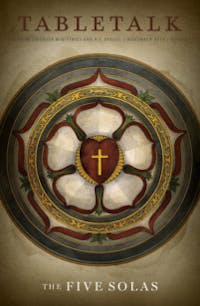
Request your free, three-month trial to Tabletalk magazine. You’ll receive the print issue monthly and gain immediate digital access to decades of archives. This trial is risk-free. No credit card required.
Try Tabletalk NowAlready receive Tabletalk magazine every month?
Verify your email address to gain unlimited access.
When you enter the sanctuary of Saint Andrew’s Chapel, you cannot help but notice the majestic pulpit that rises from the chancel and towers above the congregation. Although the pulpit is relatively plain in its structure and design, there is one unique feature to the pulpit that is noticed only upon a closer look. In the very center is an ornately carved emblem of a cross surrounded by rose petals. The emblem is a replica of the Luther Rose—the crest of the sixteenth-century Reformer Martin Luther. Luther designed the crest to teach the gospel to others, particularly the illiterate and children. The focal point of the Luther Rose draws our eyes to the central tenet of Luther’s theology—the cross.
The cross is set against the backdrop of a heart to remind us that we must believe in Christ with our hearts, which God graciously makes alive by the Holy Spirit. Rose petals surround the heart and the cross to highlight that faith in Christ results in joy, comfort, and peace on account of the finished work of Christ. The rose petals are fixed in a sky of blue to symbolize that our joy in the Holy Spirit by faith is our present hope of the future heavenly joy awaiting us. On the outer edge of the Luther Rose, encompassing the entire emblem, is a gold ring symbolizing the heavenly riches awaiting us in the eternal glory of heaven.
Just as the Luther Rose on the front of the pulpit at Saint Andrew’s Chapel is not intended to draw eyes to Luther but to the gospel he preached, so the height of the pulpit is not intended to elevate the man in the pulpit but the gospel he preaches. The gospel of Jesus Christ is the power of God and the only way to God, and, in the providence of God, this is the truth that ignited Luther and set the world ablaze in the Reformation of the sixteenth century. The Reformers did not teach anything new but sought to recover biblical truth and restore the church to her biblical foundations. The five solas (sola is Latin for “alone”) that emerged from the Reformation capture the heart of the Reformation and the heart of the gospel.
At the time of the Reformation, the word sola became a necessary qualifier in order to guard the simple truths that Scripture is our only infallible authority for faith and life, and that we are justified, or declared righteous, by God’s grace alone, through faith alone, because of Christ alone, and all for the glory of God alone. And, make no mistake, we are not justified by believing the solas but by believing in Christ, and we guard these solas not merely for the sake of an event that took place five hundred years ago in Europe, but for the sake of the event that took place two thousand years ago on a hill outside Jerusalem.
